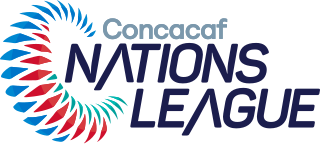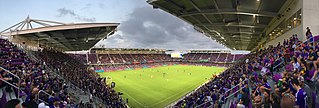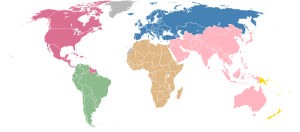The Caribbean Club Championship, also known as the CFU Club Championship or CFU Club Champions' Cup, was an annual international football competition held amongst association football clubs that are members of the Caribbean Football Union (CFU). The tournament served as a qualifying event for the CONCACAF Champions League and, from 2017, the CONCACAF League.

The 2008–09 CONCACAF Champions League was the 44th edition of the premier association football club competition organized by CONCACAF, the regional governing body of North America, Central America, and the Caribbean. This was the first iteration of the competition to be known as CONCACAF Champions League, having been previously known as the CONCACAF Champions' Cup.

The 2009–10 CONCACAF Champions League was the second edition of the CONCACAF Champions League.Under its current format, and overall, it was the 45th edition of the premier football club competition organized by CONCACAF, the regional governing body of North America, Central America and the Caribbean.

The 2010–11 CONCACAF Champions League was the 3rd edition of the CONCACAF Champions League under its current format, and overall the 46th edition of the premier football club competition organized by CONCACAF, the regional governing body of North America, Central America and the Caribbean. The tournament began on July 27, 2010 and ended on April 27, 2011. Monterrey of Mexico won their first title, defeating Real Salt Lake of the United States 3-2 on aggregate in the final. As winners, Monterrey qualified for the 2011 FIFA Club World Cup as the CONCACAF representative.

The 2011–12 CONCACAF Champions League was the 4th edition of the CONCACAF Champions League under its current format, and overall the 47th edition of the premier football club competition organized by CONCACAF, the regional governing body of North America, Central America and the Caribbean. The tournament began on July 26, 2011 and finished with the second leg of the final April 25, 2012.

The 2012–13 CONCACAF Champions League was the 5th edition of the CONCACAF Champions League under its current name, and overall the 48th edition of the premier football club competition organized by CONCACAF, the regional governing body of North America, Central America and the Caribbean. It remained a 24-team tournament, but the format changed for this edition. CCL play began on July 31, 2012, and finished on May 1, 2013. The winner qualified as the CONCACAF representative for the 2013 FIFA Club World Cup.

The 2022 FIFA World Cup qualification was the qualifying process which decided the 31 teams that would join hosts Qatar, who received an automatic spot, at the 2022 FIFA World Cup.

The 2013–14 CONCACAF Champions League was the 6th edition of the CONCACAF Champions League under its current name, and overall the 49th edition of the premier football club competition organized by CONCACAF, the regional governing body of North America, Central America and the Caribbean. Monterrey were the three-time defending champions, but were unable to defend their title as they failed to qualify for the tournament.
The 2012 CONCACAF Champions League final was the final of the 2011–12 CONCACAF Champions League, the 4th edition of the CONCACAF Champions League under its current format, and overall the 47th edition of the premium football club competition organized by CONCACAF, the regional governing body of North America, Central America, and the Caribbean.

The 2014–15 CONCACAF Champions League was the 7th edition of the CONCACAF Champions League under its current name, and overall the 50th edition of the premier football club competition organized by CONCACAF, the regional governing body of North America, Central America, and the Caribbean.
The 2013 CONCACAF Champions League final was the final of the 2012–13 CONCACAF Champions League, the 5th edition of the CONCACAF Champions League under its current format, and overall the 48th edition of the premium football club competition organized by CONCACAF, the regional governing body of North America, Central America, and the Caribbean.
The 2014 CONCACAF Champions League final was the final of the 2013–14 CONCACAF Champions League, the 6th edition of the CONCACAF Champions League under its current format, and overall the 49th edition of the premium football club competition organized by CONCACAF, the regional governing body of North America, Central America, and the Caribbean.

The 2015–16 CONCACAF Champions League was the 8th edition of the CONCACAF Champions League under its current name, and overall the 51st edition of the premier football club competition organized by CONCACAF, the regional governing body of North America, Central America, and the Caribbean.
Major League Soccer teams have participated in the CONCACAF Champions Cup each season since 1997. MLS may send up to ten teams to the CONCACAF Champions Cup each season — up to six from the United States, up to one from Canada, and up to three through the Leagues Cup berths.

The 2016–17 CONCACAF Champions League was the 9th edition of the CONCACAF Champions League under its current name, and overall the 52nd edition of the premier football club competition organized by CONCACAF, the regional governing body of North America, Central America, and the Caribbean.

The CONCACAF Nations League is an international association football competition contested by the senior men's national teams of the member associations of CONCACAF, the regional governing body of North America. The tournament takes place on dates allocated for international friendlies on the FIFA International Match Calendar. A one-time qualifying tournament took place from September 2018 to March 2019 and the inaugural tournament began in September 2019.

The CONCACAF League was an annual continental club football competition organized by CONCACAF as its second-tier continental competition. It was announced on 8 May 2017.

The 2018 CONCACAF Champions League was the 10th edition of the CONCACAF Champions League under its current name, and overall the 53rd edition of the premier football club competition organized by CONCACAF, the regional governing body of North America, Central America, and the Caribbean.

The 2020 CONCACAF Champions League final was the final match of the 2020 CONCACAF Champions League, the 12th edition of the CONCACAF Champions League under its current name, and overall the 55th edition of the premier association football club competition organized by CONCACAF, the regional governing body of North America, Central America and the Caribbean.















